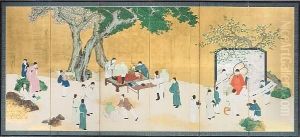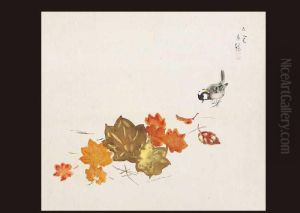Nishimura Goun Paintings
Nishimura Goun was a prominent Japanese painter and an influential figure in the development of Nihonga, a style of Japanese painting that sought to combine traditional Japanese artistic techniques with the thematic innovation of Western art. Born on February 22, 1877, in Kyoto, Japan, Goun grew up in a period of significant cultural and artistic transformation. The Meiji Restoration, which began in 1868, had opened Japan to the West, leading to a rapid modernization and westernization of Japanese society, including its art forms. Amidst this backdrop, Goun dedicated himself to the study and advancement of Nihonga, striving to preserve the unique characteristics of Japanese art while embracing the evolving global artistic landscape.
Goun was deeply influenced by the works of earlier masters such as Maruyama Ōkyo and the Rimpa school, known for their refined and decorative styles that celebrated the beauty of the natural world. He trained under Kikuchi Hōbun and later with Hashimoto Gahō, two masters who were pivotal in his development as an artist. Goun's works are characterized by their delicate beauty, meticulous detail, and a profound sense of harmony and balance. He often depicted traditional Japanese subjects, such as landscapes, flowers, and birds, infusing them with a modern sensibility that made his work popular among both Japanese and international collectors.
Throughout his career, Goun contributed significantly to the Nihonga movement, participating in and receiving accolades at many domestic and international exhibitions. His efforts in promoting Nihonga helped to ensure its survival and relevance in a time of rapid modernization. Goun was also a respected teacher, passing on his techniques and philosophies to a new generation of artists, thus ensuring the continuity of the Nihonga tradition.
Nishimura Goun passed away on October 10, 1938, leaving behind a legacy that continues to influence Japanese art. His dedication to the fusion of traditional and modern artistic elements helped to define Nihonga for future generations, making him a key figure in the history of Japanese art. Today, his works are celebrated for their beauty and historical significance, and they are held in high regard in collections both in Japan and around the world.




